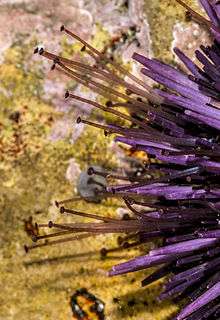Tube feet

Tube feet are small active tubular projections on the oral face of an echinoderm, whether the arms of a starfish, or the undersides of sea urchins, sand dollars and sea cucumbers. They are part of the water vascular system.[1]
Structure and function

Tube feet function in locomotion, feeding, and respiration. The tube feet in a starfish are arranged in grooves along the arms. They operate through hydraulic pressure. They are used to pass food to the oral mouth at the center, and can attach to surfaces. A starfish that is overturned simply turns one arm over and attaches it to a solid surface, and levers itself the right way up. Tube feet allow these different types of animals to stick to the ocean floor and move slowly. Tube feet consist of two parts: ampullae and podia. Ampullae contain both circular muscles and longitudinal muscle, whereas the podia contain the latter only. The podia use suction to attach to the substratum.[2][3]
References
- ↑ "Morphology". Echinodermata. University of California Museum of Paleontology.
- ↑ Smith, J. E. (1937). "The structure and function of the tube feet in certain echinoderms" (PDF). Journal of the Marine Biological Association of the United Kingdom. 22 (1): 345–357. doi:10.1017/S0025315400012042. Archived from the original (PDF) on 2013-11-15.
- ↑ Mooi, R. (1986). "Non-respiratory podia of clypasteroids (Echinodermata, Echinoides): I. Functional anatomy". Zoomorphology. 106: 21–30. doi:10.1007/bf00311943.